Red-crowned and White-naped Cranes are among the most cherished species in East Asia, not just for their grace and beauty but also because they nest in wild and remote wetlands on some of the most stunning landscapes of the region. However, their migrations take them through rapidly developing areas of China and Korea, where habitat loss and poisoning pose ever-present risks. As a result, the western populations of these species have declined precipitously in recent years.
In 1988, worried about the decline of cranes in the Amur region of southeast Russia, Vladimir and Rimma Andronova established a center for reintroducing cranes and other threatened species at Khingansky State Nature Reserve. The center’s primary purpose was to reintroduce Red-crowned and White-naped Cranes by raising chicks, either through the rearing of chicks by adult pairs or by hand-rearing birds in captivity. For hand-rearing, other breeding centers or zoos sent fertilized eggs to the center. Over the years, staff transferred crane eggs from the International Crane Foundation and several zoos from the U.S., France, Belgium, Czech Republic and Russia. The eggs are incubated artificially, and for the first five months after hatching, the chicks are raised together in natural habitats. This rearing method reduces the likelihood of the young cranes imprinting on humans.
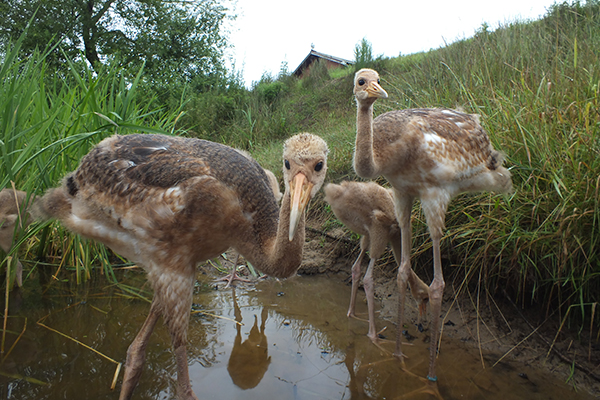
In April 2019, 12 cranes were released into the wild. Three of the cranes, two Red-crowned and one White-naped, were fitted with satellite transmitters provided by the Brno Zoo and Environmental Educational Centre in the Czech Republic. The reserve has been fruitfully cooperating with the reserve since 2015. Both Red-crowned Cranes were hand-reared by people, and the White-naped Crane was raised by adult cranes in captivity.
At first, the birds stayed around the release site, but gradually they began to investigate new areas nearby. After some time, the cranes started to make longer flights. Through field visits and satellite tracking, we observed the birds feed by themselves and saw that they did not visit settlements, which is very important for birds raised by humans. For a successful migration, these birds need to socialize and ideally migrate with wild cranes.
Tragically, in mid-October, one of the tagged Red-crowned Cranes was shot during waterfowl hunting season in the Amur Region.
Arete’s First Migration
The one-year-old White-naped Crane marked with a transmitter, named Arete, stayed separate from the Red-crowned Cranes after release. Exploring the habitat, he visited protected areas in the Amur basin, and in July 2019, he spent two weeks in northeastern China before returning to Russia. In October, just before migration, he spent time in an Amur game refuge, which hosts large migratory flocks of White-naped and Hooded Cranes. Arete’s migration route is indicated by the blue lines in the below map.
Having started the autumn migration on November 3, Arete flew through China to the Korean Peninsula in three days and spent the winter in North Korea near the border with South Korea.
He began his spring migration on March 9, 2020, stopping over along the Tumen River on the Russia, North Korea and China border and further north near Ussuri city. Russian ornithologists Yuri Glushchenko, Dmitry Korobov and Sergey Surmach, observed large flocks of White-naped Cranes (250-300) in these areas at this time, giving us hope that our crane was in a flock with the same species. On April 8, Arete flew back to the Amur region and spent much of the summer wandering around this area feeding on nearby farmlands.
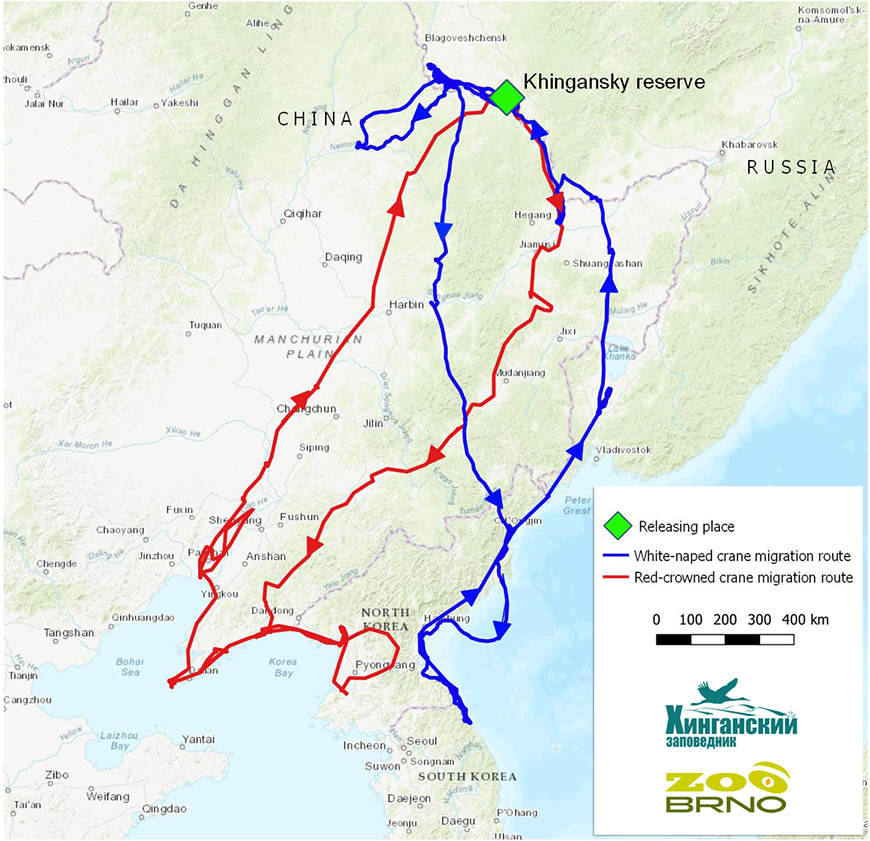
The story of Bomnak
The female Red-crowned Crane named Bomnak was tagged and released as a two-year-old in spring 2019. She spent time after release in the buffer zone of the Khingansky reserve and began the autumn migration on November 1. Bomnak’s migration route is indicated by the red lines in the above map. She flew along the Amur River and crossed the Lesser Khingan Mountains and northern China to arrive in North Korea, where she spent 40 days in November and December, in the middle reaches of the Taeryong river near Pakchon city. In mid-December, the bird returned to the Liaodong peninsula, where she stayed until the beginning of March 2020 near Lushun, south of Dalian city.
Luckily, this area of China has a very active bird conservation community. With the help of our Chinese partners – Prof. Guo Yumin of Beijing Forestry University, Mr. Wen Bo, founder of the ecological organization Blue Dalian, Ms. Sun Kang, founder of the Lushun Bird Conservation Association and Mr. Wang Xiaoping of the Laotieshan Nature Reserve – we discovered that Bomnak was accompanied by a wild bird at this time. The birds stayed at an old salt field built during Japanese occupation nearly a century ago. Now, these fields are used as fish and shrimp ponds.
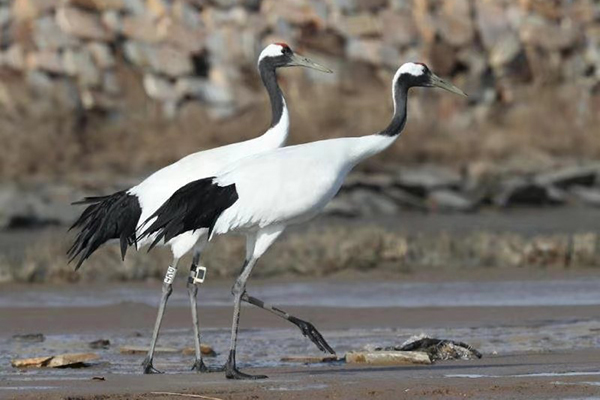
Bomnak began her spring migration on March 5, 2020, but unfavorable weather conditions held her back a week. She flew 200 km to northern China, stopping in Inner Mongolia and Jilin provinces before arriving back at Khingansky reserve at the end of March. A survey of this area showed that she returned from the wintering grounds with a mate. They settled in suitable breeding habitat and exhibited territorial behavior, such as unison calling and joint flights.
At the end of April, transmitter data showed that the birds’ behavior patterns changed and indicated, with a high degree of probability, that they had built a nest and started incubating eggs. . In June, we rechecked Bomnak’s nest with the drone. This time we were delighted to see our crane pair with two chicks! For Bomnak, now a three-year-old female, this was her first breeding season. And it was successful! Furthermore, it appears that Bomnak’s behavior is no different from the wild birds. She occupied a territory and successfully raised two chicks in the reserve.
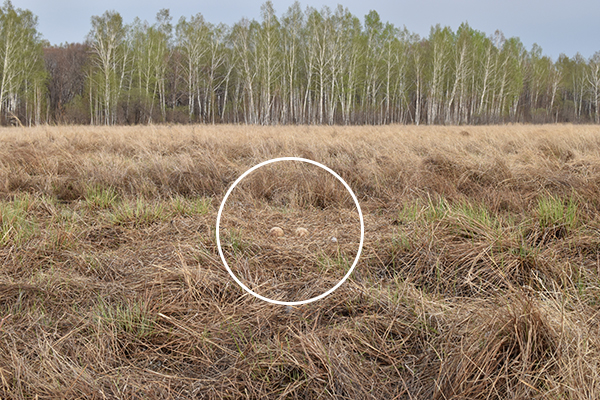
Annual releases of cranes have been conducted in the reserve since 1991. In total, 106 Red-crowned and 62 White-naped Cranes have been released into the wild. During this time, reserve staff received information from wintering and breeding areas of 26 Red-crowned and 27 White-naped Cranes (24.5% and 43.5 % of those released, respectively). This information includes cranes in pairs and those with chicks.
Bomnak is the eighth bird from the released Red-crowned Cranes known to have paired after being released into the wild. It’s very difficult to detect released cranes on the breeding grounds without special equipment, considering the vast territory and inaccessibility of breeding sites. We think this is the reason we know little of the fate of released birds. However, new technical capabilities give us the chance to learn more about them. The transmitter shows the crane’s location, while the drone makes it possible to locate birds, assess their status and physical condition, something that is very difficult to do even with the help of good optics.
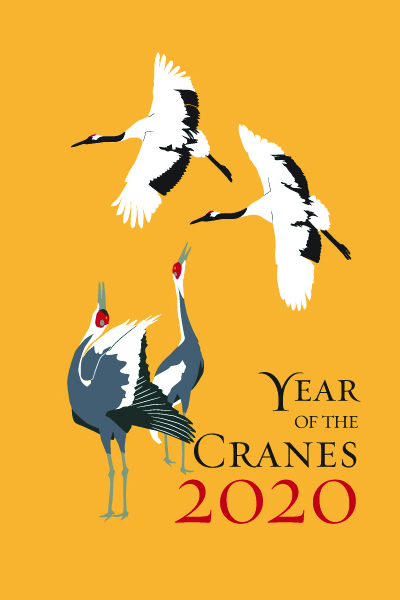
Year of the Cranes
The International Crane Foundation, the Working Group on Eurasian Cranes, the International Union for Conservation of Nature, the Union for the Conservation of Birds of Russia and the Far Eastern Branch of the World Wildlife Fund declared 2020 the Year of the Cranes. The news about Bomnak’s nesting is a wonderful gift for those who help raise, study and protect cranes and indeed to everyone who loves nature.
Despite the difficulties caused by the worldwide Coronavirus pandemic, Brno Zoo brought us two Red-crowned Cranes for release in 2021. In addition, RusHydro company provided significant financial support to the reintroduction facility, and the World Wildlife Fund supported an aerial survey of cranes by unmanned aerial drones.
As of late November, Arete has arrived at Cheorwon, along the DMZ in South Korea, the principal staging and wintering area of White-naped Cranes of the Eastern Flyway. Bomnak has flown to Yancheng National Nature Reserve in Jiangsu, southeast China, the principal wintering area of the western flyway population of Red-crowned Cranes. This is adding to our information about crane flyways. Bomnak may also have gone to Cheorwon. This is where many Red-crowned Cranes winter, and last year she spent time in North Korea. But they chose their places (or maybe their mates do?) Regardless, when you raise and follow these birds, they become part of your family, and their future becomes more personal!
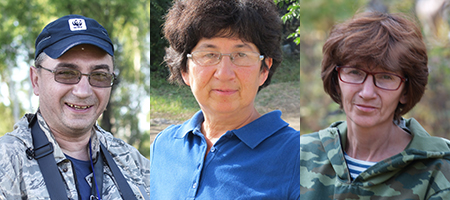 Story submitted by Mikhail Parilov, Nadezhda Kuznetsova and Irina Balan, Khingansky State Nature Reserve.
Story submitted by Mikhail Parilov, Nadezhda Kuznetsova and Irina Balan, Khingansky State Nature Reserve.
